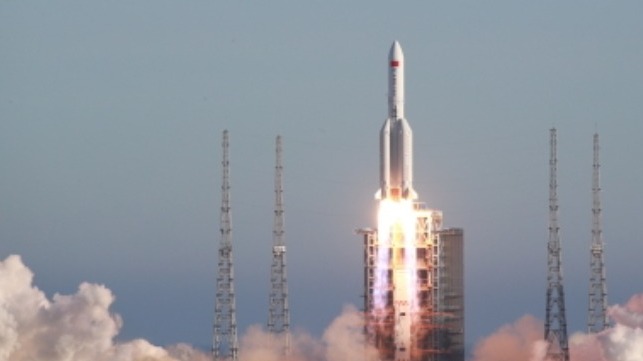Maldives Coast Guard Watches for Debris From China's Long March Rocket

The Maldives' coast guard has launched a search for debris from a Chinese Long March 5B rocket that re-entered the atmosphere over the Indian Ocean on Saturday.
After a successful launch on April 29, the 40,000 pound Long March 5B booster fell gradually back into the atmosphere in a planned uncontrolled descent. The potential area of re-entry spanned all locations between latitudes 41.5 N and 41.5 S, according to the European Space Agency.
The uncontrolled nature of the re-entry drew protests from some Western scientists and diplomats. "Spacefaring nations must minimize the risks to people and property on Earth of re-entries of space objects and maximize transparency regarding those operations," said NASA administrator Sen. Bill Nelson in a statement Sunday. "China is failing to meet responsible standards regarding their space debris."
Jonathan McDowell, an astronomer at the Harvard-Smithsonian Center for Astrophysics, told CNN last year that the largest components of a rocket that size could survive re-entry and cause localized damage to small structures.
China's human spaceflight agency, CMS, put the location of the splashdown in the Indian Ocean at position 072.47 E 02.65 N, about 25 nm to the west of the inhabited island of Kudahuvadhoo, South Nilande Atoll. The office said that most of the debris burnt up on reentry.
In a statement, U.S. Space Command confirmed that the debris re-entered the atmosphoere over the Arabian Peninsula on Saturday. It declined to provide further tracking information.
For its part, China's state-owned media suggested that the rocket launch was much like any other.
"Analysts of foreign affairs pointed out that it reflects the double standards of the West in an attempt to sabotage China's space station construction plan, exposing their military intentions to track China's space hardware," wrote the state-owned Global Times.
The U.S.-funded Aerospace Corporation said that the Long March 5B mission was unusual in that the heavy first-stage booster traveled up into orbit with the payload instead of falling downrange. Once in orbit, it gradually came back to earth without further human control.
The launch carried the main habitation module for China's new manned space station, the Tianhe, which is scheduled for first operations in 2022.
